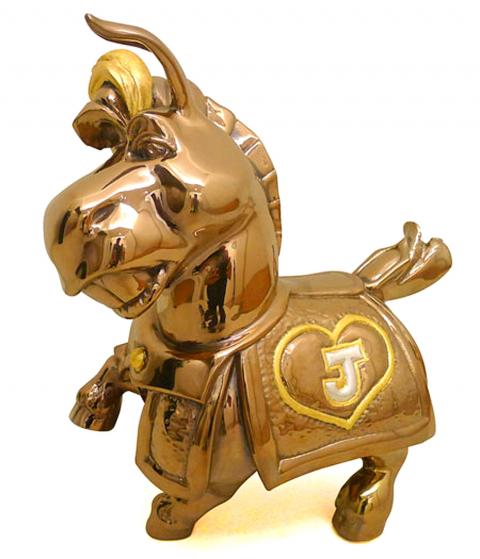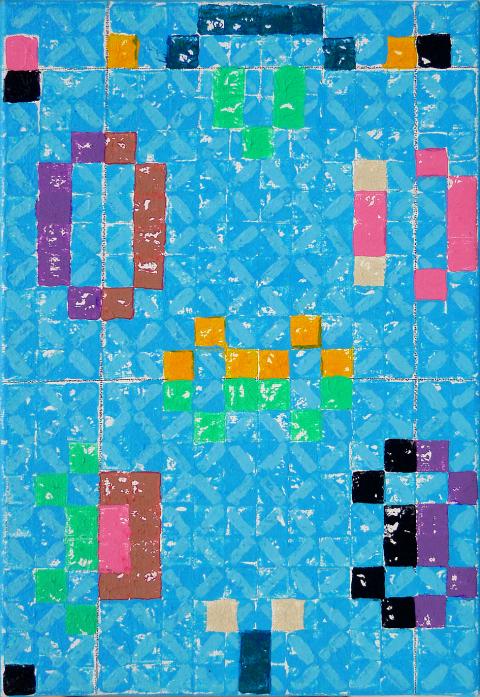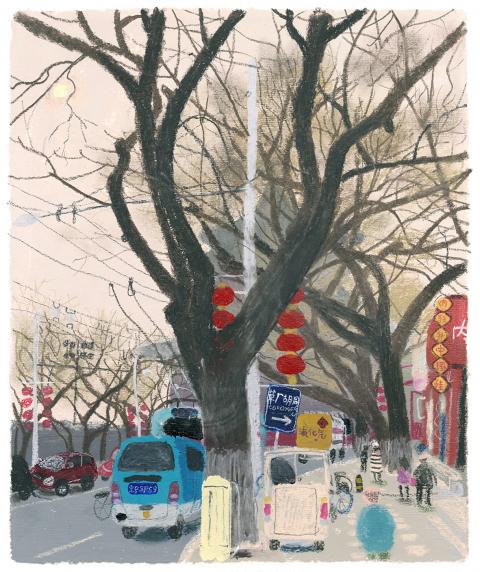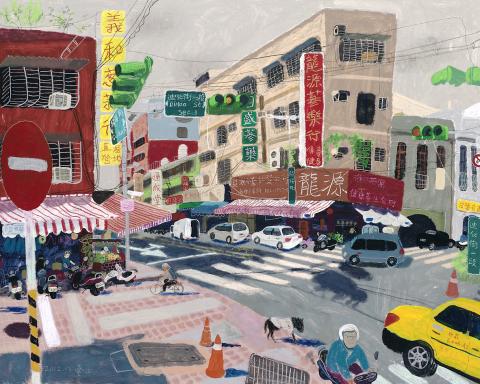Start from Zero: Small with Infinitely Large (從零開始 — 無限的大小) is a group exhibition of established artists from Taiwan (including new work by Tsong Pu (莊普), Yao Jui-chung (姚瑞中) and Wu Tien-chang, 吳天章) — China and South Korea working in sculpture, painting and installation. With such a broad range of artists (35 in all), the gallery seems more interested in name recognition than any overall theme. That being said, there is much on view here and for anyone wanting a brief introduction to what preoccupies contemporary Asian artists — whether the continued interest in geometrical abstraction as shown by the work of Keng Hao-kang (耿?剛) or the heroic, yet humorously kitschy, sculptures of Yang Mao-lin (楊茂林) — you could do far worse.
■ Metaphysical Art Gallery (形而上畫廊), 7F, 219, Dunhua S Rd Sec 1, Taipei City (台北市敦化南路一段219號7樓), tel: (02) 2711-0055. Open Tuesdays to Sundays from 11am to 6:30pm
■ Until March 24

Photo courtesy of Metaphysical Art Gallery
VT Artsalon begins 2013 with two solo exhibitions of painting, The Beauties by Agi Chen (陳怡潔), and Dorothy Crash (桃樂絲墜落) by Kao Ya-ting (高雅婷). Chen creates paintings using cartoon and anime characters specified by members of a Facebook page called Circle Island. This collaborative method of artist and viewer provides an aesthetic record of a virtual community — their stories, desires and memories. Kao’s travels last year to the US and Brazil inspired her paintings in Dorothy Crash. More a travelogue, perhaps, then a coherent statement, Kao’s work reflects on her family and childhood memories through the locales she visits.
■ VT Art Salon (非常廟藝文空間), B1, 47 Yitong St, Taipei City (台北市伊通街47號B1), tel: (02) 2516-1060. Open Tuesdays through Thursdays from 1:30pm to 9pm, and Fridays and Saturdays from 1:30pm to 10pm
■ Until Thursday

Photo courtesy of Metaphysical Art Gallery
Chinese artist Wang Yuping (王玉平) recently spent a month in Taipei where he captured the winter and rain on the streets of Danshui and Western Taipei, as well as recorded Taiwanese cuisine. Taipei, Beijing (台北‧北京) also includes a number of cityscape watercolors of Beijing. Wang often mixes acrylic paint with oil pastel or oil paint on handmade paper. The resulting works radiate a loose, dynamic and random atmosphere.
■ Eslite Gallery (誠品畫廊), 5F, 11 Songgao Rd, Taipei City (台北市松高路11號5樓), tel: (02) 8789-3388 X1588. Open Tuesdays to Sundays from 11am to 7pm
■ Until April 7

Photo courtesy of Eslite Gallery
Recalling the history and development of new media art, which began in the 1960s as a response to Dada and Conceptual Art and advances in scientific and industrial technologies, The Innovationists (因腦維新族) provides a comprehensive look at new media art through 18 works covering sound, light and video. According to the museum, the artists, hailing from the US, the UK, Japan, Hong Kong and Taiwan, unite an experimental ethos with concepts of technology, design and creativity. Among the more interesting pieces: An interactive and wearable device that sheds light on the culture of Otaku (what the museum blurb describes as “geeks” and “computer nerds”), kinetic installations that draw attention to environmental concerns and sculptures that present a new kind of urban architecture. The exhibition benefits from not only providing a brief introduction of new media art, but also illustrates how contemporary artists are building on a young tradition.
■ Museum of Contemporary Art, Taipei (MOCA, Taipei), 39 Changan W Rd, Taipei City (台北市長安西路39號), tel: (02) 2552-3720. Open Tuesdays to Sundays from 10am to 6pm. General admission: NT$50
■ Until April 4

Photo courtesy of Eslite Gallery
Water preoccupies the thinking of the artists in Troubled Waters — especially its relationship to the land and how it has become a focus for global concerns about the environment. Aspects of heritage, history, representation, cultural discourse and our relationship to the means of production will also be explored through the work of the five artists and their accompanying texts. The exhibition includes single screen and spatial video installations, sound and photographic works, sculptural elements and light works.
■ Kuandu Museum of Fine Arts (關渡美術館), 1 Xueyuan Rd, Taipei City (台北市學園路1號), tel: (02) 2893-8870. Open Tuesdays to Sundays from 10am to 5pm
■ Begins March 8. Until May 5

In the March 9 edition of the Taipei Times a piece by Ninon Godefroy ran with the headine “The quiet, gentle rhythm of Taiwan.” It started with the line “Taiwan is a small, humble place. There is no Eiffel Tower, no pyramids — no singular attraction that draws the world’s attention.” I laughed out loud at that. This was out of no disrespect for the author or the piece, which made some interesting analogies and good points about how both Din Tai Fung’s and Taiwan Semiconductor Manufacturing Co’s (TSMC, 台積電) meticulous attention to detail and quality are not quite up to

It is one of the more remarkable facts of Taiwan history that it was never occupied or claimed by any of the numerous kingdoms of southern China — Han or otherwise — that lay just across the water from it. None of their brilliant ministers ever discovered that Taiwan was a “core interest” of the state whose annexation was “inevitable.” As Paul Kua notes in an excellent monograph laying out how the Portuguese gave Taiwan the name “Formosa,” the first Europeans to express an interest in occupying Taiwan were the Spanish. Tonio Andrade in his seminal work, How Taiwan Became Chinese,

Mongolian influencer Anudari Daarya looks effortlessly glamorous and carefree in her social media posts — but the classically trained pianist’s road to acceptance as a transgender artist has been anything but easy. She is one of a growing number of Mongolian LGBTQ youth challenging stereotypes and fighting for acceptance through media representation in the socially conservative country. LGBTQ Mongolians often hide their identities from their employers and colleagues for fear of discrimination, with a survey by the non-profit LGBT Centre Mongolia showing that only 20 percent of people felt comfortable coming out at work. Daarya, 25, said she has faced discrimination since she

April 21 to April 27 Hsieh Er’s (謝娥) political fortunes were rising fast after she got out of jail and joined the Chinese Nationalist Party (KMT) in December 1945. Not only did she hold key positions in various committees, she was elected the only woman on the Taipei City Council and headed to Nanjing in 1946 as the sole Taiwanese female representative to the National Constituent Assembly. With the support of first lady Soong May-ling (宋美齡), she started the Taipei Women’s Association and Taiwan Provincial Women’s Association, where she